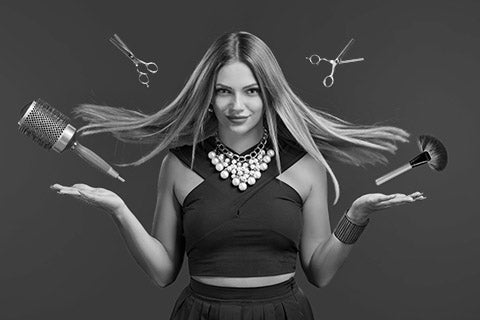Navigating Difficult Hair Types: Expert Solutions for Common Challenges
Posted on September 19 2024
As a hair professional, you're bound to encounter a range of hair types that present unique challenges. Whether you're dealing with curly textures, thinning hair, or damaged strands, knowing how to properly care for and style difficult hair types is essential. Not only does it demonstrate your expertise, but it also builds client trust and loyalty. Here’s a detailed guide to navigating some of the most common hair challenges and offering expert solutions for each.
1. Curly & Coarse Hair
Curly and coarse hair types are naturally dry due to the structure of the hair shaft, which makes it difficult for the scalp’s natural oils to travel down the strands. This results in frizz, dryness, and breakage if not properly cared for.
Solution:
- Hydration is key. Use sulfate-free shampoos and moisturizing conditioners to cleanse the hair without stripping its natural oils.
- Deep conditioning treatments should be a regular part of the routine. Recommend weekly or bi-weekly masks with ingredients like shea butter, argan oil, or glycerin to lock in moisture and prevent frizz.
- Styling: Use a leave-in conditioner and a curl cream to define curls. Encourage clients to air-dry or use a diffuser on a low heat setting to enhance natural texture without creating frizz. For styling, the “plopping” method using a cotton t-shirt or microfiber towel can help define curls without frizzing them out.
2. Thin or Fine Hair
Thin or fine hair can lack volume and is easily weighed down by heavy products, making it tricky to style. Clients with thin hair often struggle with flat, limp looks, and are more prone to breakage and scalp visibility.
Solution:
- Lightweight products are a must for thin hair. Avoid heavy oils or creams and instead opt for volumizing mousses, sprays, and serums that provide lift without buildup.
- Haircuts: Recommend layered, textured cuts that create volume and movement. Shorter styles or adding long layers to longer cuts can help give the illusion of thicker hair.
- Blow-drying technique: Teach clients to blow-dry their hair upside down or with a round brush to lift the roots and create extra body. For added volume, recommend a root-lifting spray or dry shampoo at the scalp.
3. Damaged Hair
Clients with damaged hair—whether from heat styling, chemical treatments, or environmental stressors—often deal with split ends, breakage, and dullness. Addressing the underlying damage is critical to restoring hair health.
Solution:
- Protein treatments help rebuild the structure of damaged hair. Incorporate a professional-strength treatment in the salon and recommend an at-home regimen that includes strengthening products with keratin, collagen, or biotin.
- Moisturize and nourish: Encourage the use of products infused with nourishing oils like argan, coconut, or avocado to help restore moisture and shine. Avoiding excessive heat styling is crucial, so recommend heat protectants when styling tools are necessary.
- Regular trims should be scheduled every 6-8 weeks to remove split ends and prevent further breakage.
4. Oily Scalp, Dry Ends
This common issue arises when the scalp produces excess sebum, while the lengths of the hair—especially in longer styles—become dry and brittle. This creates a difficult balance between preventing an oily scalp and hydrating dry ends.
Solution:
- Clarifying shampoos help regulate oil production at the scalp. Recommend clients use a clarifying shampoo once a week to prevent buildup, alternating with a gentle, sulfate-free shampoo on other days.
- Conditioning: Apply conditioners and hydrating products only to the mid-lengths and ends of the hair, avoiding the scalp. This keeps the ends moisturized without contributing to oily roots.
- Leave-in treatments: For dry ends, recommend leave-in conditioners or serums rich in nourishing ingredients like argan oil or shea butter. For clients using heat styling tools, always suggest a thermal protectant spray or cream.
5. Frizzy Hair
Frizz is a common complaint, especially in humid climates or with clients who have naturally wavy or curly hair. Frizz occurs when the hair lacks moisture and the cuticle lifts, allowing moisture from the environment to penetrate and swell the hair shaft.
Solution:
- Hydration and sealing: Frizzy hair benefits from regular hydration treatments. Recommend a leave-in conditioner combined with a silicone-based serum to help seal the cuticle and lock in moisture.
- Anti-humidity products: Suggest using anti-frizz products that contain polymers to coat the hair and block out humidity. These products can be layered with a lightweight oil to smooth down flyaways.
- Styling: Recommend air drying or using a blow-dryer with a diffuser on low heat to minimize frizz. Using a boar-bristle brush can also help smooth the hair during blow-drying.
6. Color-Treated or Chemically Processed Hair
Color-treated hair often requires extra attention due to its tendency to become dry, brittle, and prone to fading. Chemical treatments, whether for straightening or perms, can further compromise the hair’s health.
Solution:
- Color-safe shampoos and conditioners are essential for maintaining the vibrancy of the color. Recommend sulfate-free formulas that are gentle and formulated to preserve color.
- Weekly deep conditioning treatments are crucial to maintaining moisture levels and elasticity in the hair. Products containing proteins and oils will help replenish and strengthen the hair.
- Post-chemical treatment care: For clients with chemically processed hair, advise them to avoid excessive heat styling and to use leave-in treatments that provide both moisture and UV protection.
Navigating difficult hair types is all about understanding the unique needs of each client’s hair and providing them with the right solutions. Whether it's moisture for curly hair, volume for fine hair, or damage repair for over-processed locks, your expertise in identifying and addressing these challenges will set you apart as a trusted professional. By personalizing your approach and using the right combination of products and techniques, you’ll help every client achieve their hair goals and maintain healthy, beautiful hair year-round.

